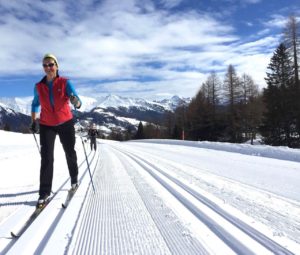Jun 15, 2022Study Links Higher Asthma Risk in Skiers with Intensive Training
An intensive training schedule is linked to a heightened risk of non-allergic asthma in competitive cross-country skiers, finds research published in the open-access journal BMJ Open Sports & Exercise Medicine.
The prevalence of non-allergic asthma was highest among the most successful skiers, suggesting that it doesn’t seem to hamper competitive chances.
Non-allergic asthma has been associated with airway infections, long-term exposure to irritants, and airway damage. It is relatively rare in childhood and early adulthood, becoming more common in older age.
 Cross-country skiers are twice as likely to develop asthma as the general population, with symptoms usually starting in the early teens. While the risk factors for allergic asthma are well known, those for different types of non-allergic asthma aren’t as clearly defined.
Cross-country skiers are twice as likely to develop asthma as the general population, with symptoms usually starting in the early teens. While the risk factors for allergic asthma are well known, those for different types of non-allergic asthma aren’t as clearly defined.
The researchers wanted to gauge the relative proportions of allergic and non-allergic asthma among competitive cross-country skiers compared with the general population. And they wanted to find out what impact performance level and training intensity might have.
They invited all Finnish cross-country skiers who had enrolled in either national championships (from the age of 17 onwards) or the largest national junior skiing Hopeasompa competition (13–16-year-olds) to fill in a questionnaire on asthma development.
Out of a total of 1282 competitive skiers, 351 responded. They were matched for age, gender, and geographical region with 338 people who weren’t cross-country skiers.
Current asthma was defined as experiencing at least one of the following: three asthma-related symptoms from among cough, chest pain, shortness of breath, wheezing, or phlegm; active use of any asthma medication or an Asthma Control Test (ACT) score of fewer than 25 points to indicate good asthma control.
Asthma was defined as allergic if the respondent had been diagnosed by a doctor and if exposure to furry animals or pollen prompted asthma-related symptoms. Otherwise, asthma was defined as non-allergic.
Skiers’ success was assessed according to the number of International Ski Federation (FIS) points accumulated for the 2018-19 season in effect at the time of the study. The fewer FIS points the skier is awarded, the better his/her performance is ranked.
Some 189 of the skiers had been diagnosed, or tested, for asthma, and 91 had current symptoms. This compares with 69 of the non-skiers, 31 of whom had current symptoms. More of the skiers used medication to control their asthma: 123 vs 39.
Around a third (36) of the 91 skiers with current asthma symptoms had allergic asthma, compared with 19 of the 31 non-skiers. But more than half of the skiers (55) with current symptoms had non-allergic asthma compared with 12 of the non-skiers.
The difference in the prevalence of non-allergic asthma between the two groups was significant (60% vs 39%), starting from the age of 14 onwards. No such difference was seen in the prevalence of allergic asthma between the two groups.
Cross-country skiers were nearly 3.5 times as likely to have asthma, nearly twice as likely to have allergic asthma, but more than 5 times as likely to have non-allergic asthma as non-skiers.
RELATED
- Study Finds ‘Conclusive Proof’ Contact Sports Leads to CTE
- Mexican Sports Medicine Specialists Adopt Multidisciplinary Approach
- IOC Launches Long-Term Study of Olympians to Help Physical & Mental Health
- Study: High School Seniors Playing Contact Sports Are 50% More Likely to Future Misuse of Prescription Stimulants
- The Title IX Impact on Women Athlete’s Sport Studies
- LSU Study Shows Football Players Bounced Back Quickly from COVID



